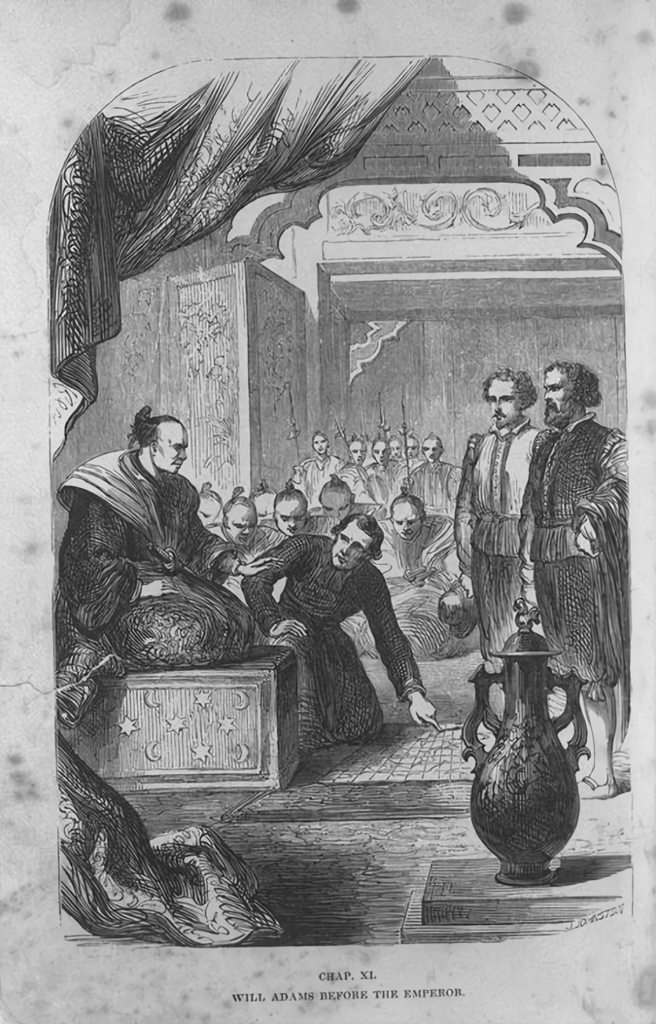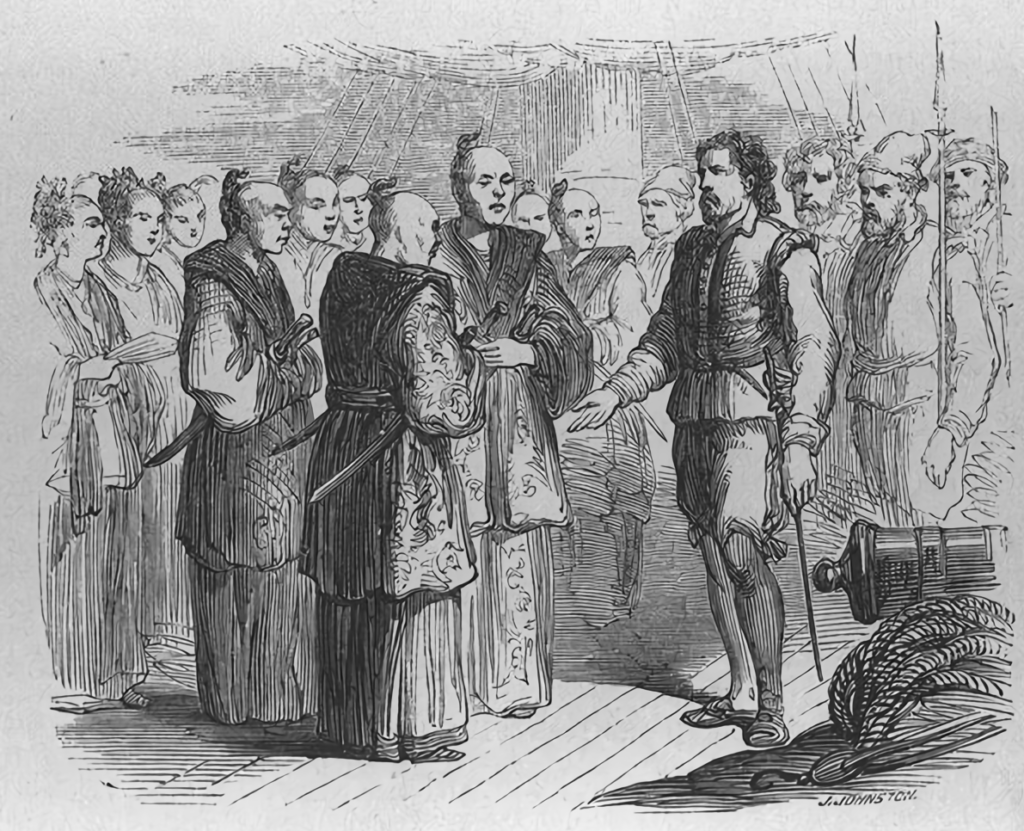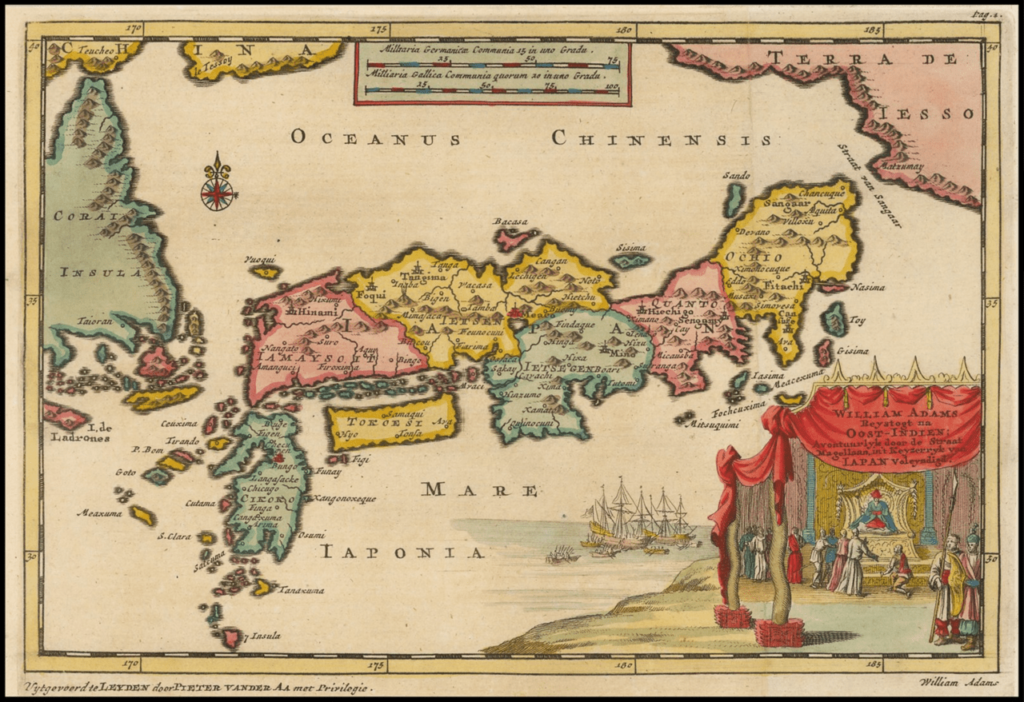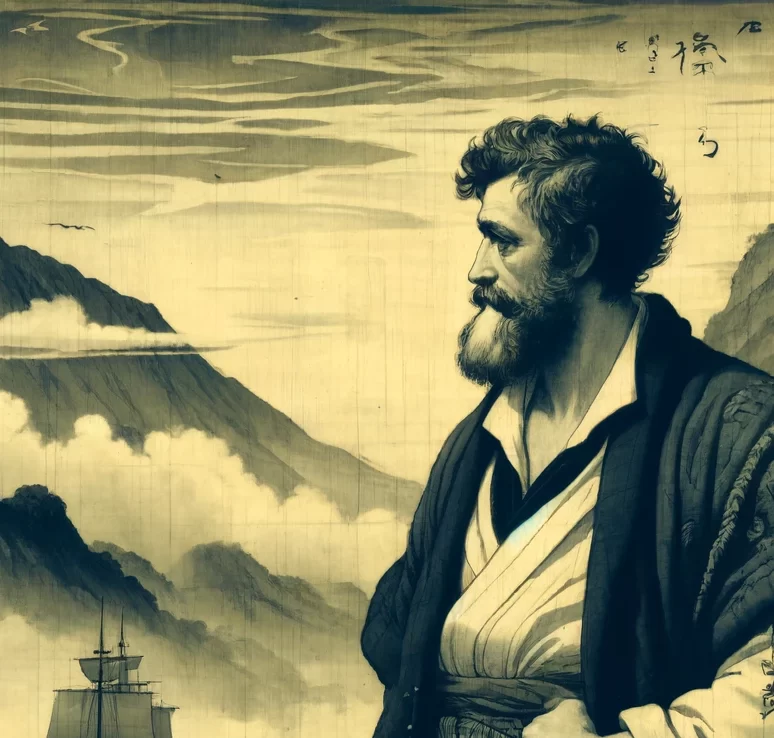Introduction
In the annals of history, where the tales of explorers and navigators abound, the story of William Adams stands out as a remarkable journey of survival, diplomacy, and cultural integration. Born in 1564 in Gillingham, Kent, England, Adams would grow to become not just a skilled navigator but a pivotal figure in the cultural and historical tapestry of Japan. His odyssey from England to the shores of Japan in the early 17th century marks one of the first recorded instances of profound interaction between the Western world and the then-mysterious land of the rising sun. Unlike many of his contemporaries whose voyages were driven by the search for new trading routes or the conquest of new lands, Adams’s journey inadvertently set the stage for an unparalleled tale of friendship, respect, and mutual understanding between two vastly different cultures.
This blog post aims to shed light on the life of William Adams, often overshadowed by the exploits of more famous explorers, and to celebrate his unique contribution to Japanese history. Adams found himself shipwrecked on the Japanese coast in 1600, a time when the country was rife with political intrigue and the brink of a new era of unification under Tokugawa Ieyasu. From these unlikely circumstances, Adams rose to become an advisor to the shogun, was granted the status of a samurai, and played a crucial role in establishing trade relations between Japan, England, and the Netherlands.
Through the sections that follow, we will explore Adams’s early life and maritime career, his harrowing journey to Japan, his deep involvement in the politics and society of his adopted country, and the lasting impact of his presence in Japan. We’ll delve into how a common seaman from England became a key figure in the complex tapestry of Japanese history and how his story provides a fascinating glimpse into the early moments of globalization and cross-cultural exchange. Join us as we journey through the life of William Adams, the Englishman who bridged worlds and whose legacy endures in both his homeland and the far-off land he came to call home.
Early Life and Maritime Career
William Adams’s story begins in the small town of Gillingham, Kent, in England, where he was born in 1564 into a modest family. Little did anyone know then that this Englishman would go on to play a significant role in the history of Japan, becoming a bridge between the East and the West during a time of immense global exploration and change. Adams’s early life, much like that of many young men of his time, was shaped by the call of the sea. The Elizabethan era was a golden age of exploration, and the tales of distant lands filled with riches and wonders inspired Adams to pursue a life at sea.
From a young age, Adams apprenticed as a shipbuilder and navigator, skills that were in high demand. This period of maritime apprenticeship not only equipped him with the essential knowledge of ship design and construction but also with the navigational skills that would later prove crucial in his journey to Japan. His early career saw him navigating the North Sea, engaging in the trade and commerce that was the lifeblood of England’s burgeoning empire.
In his mid-twenties, Adams decided to expand his horizons beyond Europe. He joined a convoy of ships on a trading voyage to the Mediterranean, a journey that would mark the beginning of his adventures beyond the familiar waters of his homeland. It was during these years that Adams honed his skills as a navigator and sailor, facing the challenges of piracy, storms, and the competitive nature of European trade in the high seas.
The pivotal moment in Adams’s maritime career came when he was hired as the chief navigator for a Dutch expedition seeking to establish a new trading route to the Far East. In 1598, Adams set sail on the Liefde, one of a fleet of five ships, with the ambitious goal of reaching Japan. The voyage was perilous, marked by disease, mutiny, and the loss of ships. By the time the Liefde reached the shores of Japan in April 1600, it was the only surviving vessel of the original fleet, and its arrival marked the beginning of a new chapter in Adams’s life.
William Adams’s early life and maritime career set the stage for his extraordinary experiences in Japan. His background as a skilled navigator and his resilience in the face of adversity equipped him with the qualities necessary to navigate the complexities of Japanese society and politics. Adams’s journey from a shipbuilder’s apprentice in Kent to a respected advisor to the shogun of Japan is a testament to the unpredictable twists of fate and the enduring human spirit of adventure and curiosity.
The Journey to Japan
The odyssey that brought William Adams to Japan is a tale of perseverance, tragedy, and the relentless pursuit of exploration. In 1598, Adams embarked on what was to be a groundbreaking expedition, joining a Dutch fleet with the lofty aim of pioneering a new trade route to the Far East. The fleet consisted of five ships, among them the Liefde, on which Adams served as the chief navigator. This expedition was not merely a commercial venture; it was an odyssey into the unknown, driven by the promise of wealth and the allure of undiscovered lands.
The journey to Japan was fraught with peril from the outset. The fleet faced numerous challenges, including violent storms, hostile encounters with Portuguese and Spanish ships, and the ever-present threat of scurvy and disease. As they navigated the treacherous waters of the Atlantic, rounded the fearsome Cape of Good Hope, and ventured into the vast expanse of the Indian and Pacific Oceans, the resolve of Adams and his crew was tested to its limits. The ships were separated during a storm, and one by one, they succumbed to the hardships of the journey.
Despite the loss of ships and many of his crewmates to the harsh realities of sea travel in the 16th century, Adams persevered. The Liefde, battered but unbowed, finally sighted the coast of Japan in April 1600, after a grueling voyage that had lasted nearly two years. It was a moment of triumph and relief, but also the beginning of a new set of challenges for Adams and the surviving crew members.
Upon their arrival, the Liefde and its crew were met with suspicion and curiosity by the Japanese. Japan was a country in the throes of political upheaval, with various factions vying for power in the lead-up to the unification under Tokugawa Ieyasu. The arrival of a foreign ship, especially one from a country as distant and unknown as England, was an event of considerable interest.
Adams and his crew were initially detained by the local daimyo (feudal lord) in Kyushu, the southernmost of Japan’s four main islands. Their fate was uncertain, as the Portuguese and Spanish, who had already established a presence in Japan, were wary of the intentions of other European powers and did not hesitate to cast aspersions on the newcomers.
However, Adams’s fluency in Dutch, a language somewhat understood by the Jesuit missionaries present in Japan, and his knowledge of shipbuilding and navigation, soon caught the attention of Tokugawa Ieyasu. Ieyasu, who was on the cusp of securing his position as Japan’s paramount leader, was intrigued by the potential advantages that Western knowledge and technology could bring to his ambitious plans for the country.
Thus began William Adams’s remarkable transformation from a detained foreign navigator to a respected advisor at the highest levels of Japanese society. His journey to Japan, filled with adversity and danger, had led him to an unexpected role in a foreign land, setting the stage for his unique contributions to Japanese history and the establishment of early contacts between Japan and the Western world.
William Adams and Tokugawa Ieyasu

The relationship between William Adams and Tokugawa Ieyasu is a fascinating tale of mutual respect and the merging of vastly different cultures, set against the backdrop of a Japan on the cusp of unification and isolation. Following Adams’s arrival in Japan in 1600, his skills as a navigator and shipbuilder, along with his knowledge of the Western world, quickly piqued the interest of Tokugawa Ieyasu, who would soon establish the Tokugawa shogunate and usher in a period of peace and stability that lasted over two centuries.
Adams’s initial encounter with Ieyasu was marked by curiosity and wariness. Ieyasu, a keen strategist and visionary, was intrigued by the potential military and economic advantages that Adams’s expertise could bring to his burgeoning empire. He was particularly interested in Adams’s knowledge of shipbuilding, navigation, and firearms, technologies that were relatively new to Japan and could significantly enhance the shogunate’s power. Moreover, Adams’s firsthand accounts of Europe and its complex politics provided Ieyasu with invaluable insights into global affairs, further cementing his status as a valuable asset.
Recognizing the opportunity before him, Adams embraced his new role with zeal. He advised Ieyasu on shipbuilding, helping to construct Japan’s first Western-style ship, which significantly improved Japan’s naval capabilities. This ship symbolized the successful transfer of technology and knowledge from West to East and marked the beginning of Japan’s engagement with global trade and diplomacy.
Beyond the technical and strategic contributions, the relationship between Adams and Ieyasu developed a personal dimension. Adams, with his straightforward manner and loyalty, earned the shogun’s trust and respect. In an extraordinary gesture of favor, Ieyasu granted Adams the title of samurai, a status unheard of for a foreigner. This not only afforded Adams a significant position within Japanese society but also lands and the corresponding responsibilities of a feudal lord. He was given the Japanese name Miura Anjin and settled in what is now part of Yokosuka City, where he lived with his Japanese wife and their children.
This unique bond between a British navigator and the most powerful man in Japan had profound implications. It facilitated the first official English presence in Japan, with Adams playing a crucial role in establishing the English trading factory in Hirado. His efforts laid the groundwork for diplomatic and commercial relations between Japan and the Western world, albeit within the strict confines of the sakoku (closed country) policy that Ieyasu and his successors would later enforce.
The friendship and collaboration between William Adams and Tokugawa Ieyasu exemplify the potential for cross-cultural exchange and understanding, even in an era dominated by conflict and competition among world powers. Adams’s story is a testament to the impact one individual can have on the course of history, bridging worlds through respect, adaptation, and shared knowledge. His legacy, encapsulated in his advisory role and the esteem in which he was held by Ieyasu, highlights the nuanced and complex nature of Japan’s engagement with the wider world during a pivotal moment in its history.
Impact on Japanese-Western Relations

William Adams’s presence and activities in Japan during the early 17th century played a crucial role in shaping the initial phase of Japanese-Western relations. His unique position as a trusted advisor to Tokugawa Ieyasu, the founding shogun of the Tokugawa shogunate, enabled him to act as a bridge between the drastically different cultures of Japan and the West. Adams’s contributions were instrumental in the establishment of the first official English presence in Japan and in fostering a period of limited but significant cultural and technological exchange before Japan’s long period of isolation.
Establishing Trade Relations
One of Adams’s most significant impacts on Japanese-Western relations was his role in facilitating the establishment of trading posts by the English and the Dutch in Japan. With his intimate understanding of Japanese customs and his unique position in Ieyasu’s court, Adams was pivotal in negotiating the permissions necessary for the English East India Company to establish a trading post in Hirado, Nagasaki Prefecture. This trading post became a hub for the exchange of goods such as silk, spices, and porcelain from Japan to England, and woolen textiles and other European goods to Japan. Similarly, the Dutch were also able to secure a trading post, largely thanks to the groundwork laid by Adams’s diplomacy and his efforts to demonstrate the benefits of such international trade to Japan.
Influence on Shipbuilding and Technology Transfer
Adams’s expertise in shipbuilding and navigation was eagerly utilized by the Tokugawa shogunate. Under his guidance, Japan built its first Western-style sailing ships, marking a significant leap in Japanese naval technology. These ships were used not only for domestic purposes but also played a role in Japan’s exploratory and trading ventures. This transfer of knowledge from West to East showcased the potential benefits of cross-cultural exchange and contributed to Japan’s growing interest in Western technology and science, albeit within the controlled parameters set by the shogunate.
Personal Diplomacy and Cultural Exchange
Beyond the tangible impacts of trade and technology transfer, Adams’s unique story facilitated a deeper, if not fully realized, cultural exchange between Japan and the West. Through his marriage to a Japanese woman and his assimilation into Japanese society as a samurai, Adams embodied the potential for a harmonious blend of Eastern and Western cultures. His personal relationships with Japanese officials, including Tokugawa Ieyasu himself, helped demystify the foreign and fostered a sense of curiosity and respect that transcended the typical mercantile relationships of the time.
Prelude to Isolation
However, Adams’s influence also had unintended consequences. The success of the English and Dutch trading posts highlighted the potential dangers of unchecked foreign influence, contributing to the Tokugawa shogunate’s decision to enact the sakoku (closed country) policy. By the mid-17th century, Japan had severely restricted its interactions with the outside world, allowing only a very limited Dutch presence in Nagasaki. While this policy was influenced by many factors, the early years of interaction, in which Adams played a significant role, demonstrated both the benefits and the perceived threats of foreign engagement, shaping the shogunate’s approach to international relations.
William Adams’s impact on Japanese-Western relations during the pivotal early years of the Tokugawa shogunate cannot be overstated. His role as a mediator, advisor, and symbol of cross-cultural exchange opened doors for the first significant interactions between Japan and the Western world. While his contributions paved the way for a brief period of exchange and mutual curiosity, they also played a part in setting the stage for Japan’s eventual turn towards isolation. Adams’s legacy, therefore, is a complex tapestry of diplomacy, cultural bridging, and the delicate balance of international relations in an era of global exploration and empire-building.
Legacy and Historical Significance

William Adams’s journey from an English navigator to a respected advisor in the court of Tokugawa Ieyasu and his eventual assimilation into Japanese society as a samurai is a narrative that resonates through the annals of history. His unique story not only provides a fascinating insight into the complexities of early 17th-century global interactions but also underscores the profound impact an individual can have on the course of international relations and cultural exchange. Adams’s legacy and historical significance are multifaceted, reflecting the intricate dynamics of his time and the lasting impressions he left on both Japan and the West.
A Bridge Between Cultures
Adams is often celebrated as a bridge between Japanese and Western cultures at a time when such connections were exceedingly rare. His ability to navigate the complexities of Japanese society, gain the trust of one of its most powerful leaders, and contribute significantly to Japan’s naval and diplomatic endeavors exemplifies the potential for constructive cross-cultural engagement. Through his personal and professional relationships, Adams facilitated a level of understanding and exchange that was unprecedented for its time, setting a precedent for international diplomacy and cultural curiosity.
Influence on Trade and Diplomacy
The role Adams played in establishing the first English trading post in Japan, along with his contributions to enhancing Japanese shipbuilding and navigational techniques, mark him as a key figure in the early stages of global trade networks. His efforts not only opened up new avenues for trade but also contributed to the flow of knowledge and technology between East and West. This period of initial contact and exchange would have lasting effects on the development of international trade and diplomacy, showcasing the importance of individuals in shaping global history.
Enduring Legacy in Japan and England
In Japan, William Adams is remembered as Miura Anjin, a testament to his successful integration into Japanese society and his contributions to the country. His gravesite in Hirado and the annual ceremonies held in his honor reflect the deep respect and enduring legacy he has in Japan. Similarly, in England and the Netherlands, Adams is celebrated as a pioneering navigator whose experiences in Japan offer valuable insights into the early modern period’s global explorations. Monuments, books, and various cultural depictions pay tribute to his remarkable life and adventures.
Representation in Literature and Popular Culture
Adams’s life story has inspired numerous works of literature and popular culture, most notably James Clavell’s novel “Shogun,” which, while fictionalized, introduces the essence of his experiences to a wide audience. These portrayals have contributed to the mythologizing of Adams as a figure who transcends his historical achievements, embodying the spirit of adventure, cultural integration, and the potential for mutual respect and understanding between different worlds.
Reflection on Globalization and Cultural Exchange
William Adams’s story is a poignant reminder of the complexities and possibilities of early globalization and cultural exchange. His experiences highlight the challenges and opportunities presented by encounters between different cultures and underscore the role of individuals in bridging divides and fostering understanding. In a world that continues to grapple with the dynamics of cultural interaction, Adams’s legacy serves as a powerful example of how openness, respect, and curiosity can lead to constructive and lasting relationships.
Conclusion
The extraordinary life of William Adams, an English navigator who became a trusted samurai and advisor in the court of Tokugawa Ieyasu, is more than just a tale of adventure and survival. It’s a narrative that deeply enriches our understanding of global history, illustrating the profound effects of individual actions on the course of international relations and cultural exchange. Adams’s journey from the shores of England to the heart of feudal Japan showcases the incredible potential for cross-cultural understanding and cooperation, even in times and places where such outcomes seem least likely.
Adams’s legacy, encompassing his contributions to Japanese naval technology, diplomacy, and the initial stages of Japan’s engagement with the Western world, highlights the impact one person can have on the development of global networks of trade and communication. His life reminds us of the possibilities that arise from curiosity, respect, and the willingness to learn from and with those whose experiences and perspectives differ from our own.
Furthermore, Adams’s story continues to captivate and inspire, reflected in literature, popular culture, and the commemorations that take place in both Japan and England. These tributes not only honor his memory but also serve as a bridge between the past and present, encouraging contemporary audiences to reflect on the complexities and rewards of cultural exchange.
In a world that remains marked by cultural divides and misunderstandings, the story of William Adams stands as a testament to the enduring power of open-mindedness and the potential for individuals to bridge worlds. It challenges us to consider how, in our own ways, we might contribute to a deeper understanding and cooperation across cultures. Adams’s life and legacy invite us to embrace the spirit of adventure and curiosity, reminding us that even in the face of seemingly insurmountable barriers, mutual respect and learning can lead to lasting impacts and friendships.
As we conclude this exploration of William Adams’s remarkable life, we are reminded that history is not just a series of events but a tapestry woven from the stories of individuals who, whether by choice or circumstance, have stepped beyond the familiar to engage with the wider world. Adams’s legacy is a call to look beyond our horizons, to seek understanding and connection, and to appreciate the richness and diversity of the human experience.
Further Reading and References
For those intrigued by the life and legacy of William Adams and wish to delve deeper into his story and the broader context of his times, the following list of books, articles, and resources offers a starting point for further exploration. These references span historical accounts, scholarly analyses, and works of fiction inspired by Adams’s extraordinary journey.
Books
- “Samurai William: The Englishman Who Opened Japan” by Giles Milton. This engaging narrative provides a comprehensive look at William Adams’s life, from his early years in England to his remarkable adventures in Japan. Milton combines historical detail with storytelling flair to bring Adams’s story vividly to life.
- “The Closed World of Tokugawa Japan” by Marius B. Jansen. For those interested in the broader historical and cultural context of Japan during Adams’s time, Jansen’s work offers an insightful analysis of the Tokugawa period’s policies, society, and international relations.
- “Shogun: The Epic Novel of Japan” by James Clavell. While a work of fiction, Clavell’s novel is inspired by the life of William Adams and provides a dramatic portrayal of feudal Japan. It offers a compelling, though fictionalized, narrative that captures the imagination and introduces readers to the period’s cultural and political complexities.
Articles and Papers
- “William Adams and Early English Enterprise in Japan” published in the Journal of Pacific History. This scholarly article explores Adams’s contributions to the establishment of English trading ventures in Japan and his role in early Anglo-Japanese relations.
- “Navigators and Naturalists: British Exploration of the Pacific in the Eighteenth Century” in The Mariner’s Mirror. For those interested in the broader theme of European exploration in the Pacific, this article places Adams’s journey in the context of later exploratory and scientific ventures.
Online Resources
- The British Library offers a collection of manuscripts and documents related to William Adams and early English encounters with Japan. Their online catalog and digital collections provide access to primary sources and scholarly commentary.
- The National Archives (UK) also houses documents and records pertaining to William Adams and the early English presence in Japan. Their online portal includes guides and exhibitions that explore this fascinating period of history.
- The Japan Society occasionally publishes articles, hosts lectures, and organizes events that explore the historical connections between Japan and the UK, including the story of William Adams.
Cultural Sites and Memorials
- Hirado, Nagasaki Prefecture, Japan, where a statue of William Adams and his grave can be found. Visiting these sites offers a tangible connection to Adams’s story and the impact of his life in Japan.
- Gillingham, Kent, England, Adams’s birthplace, where local history groups commemorate his legacy and contributions to Anglo-Japanese relations.
These resources provide a variety of perspectives on William Adams’s life and the era in which he lived, offering readers pathways to a deeper understanding of the historical interactions between Japan and the West. Whether through academic research, literary exploration, or cultural travel, the story of William Adams serves as a gateway to discovering the rich tapestry of global history and the enduring power of cross-cultural exchange.

